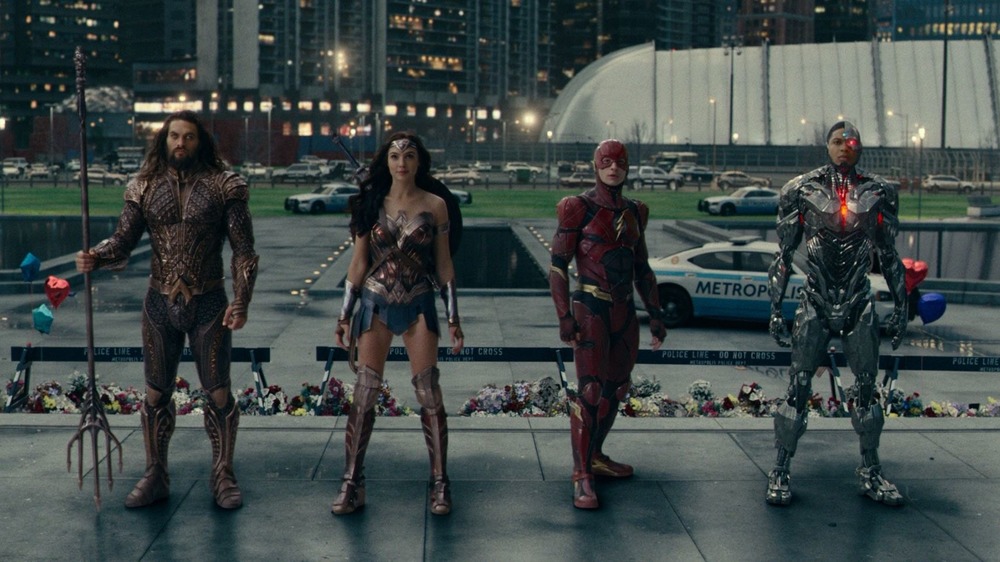How Joss Whedon Really Ended Up Taking Over On Justice League
On March 18, a years-long confluence of weirdness looks set to reach a conclusion, with the release of the much-anticipated "Snyder Cut" of Justice League. Depending on who you ask, it's either a historic moment in Hollywood history when a fan base rallied to wrest control from a corrupt studio system, or it's an internet-wide temper tantrum given cinematic form at a level not seen since Snakes on a Plane. Whatever the case, we are now mere weeks removed from a world where Batman says bad words and Darkseid has, by all appearances, come to town.
The saga of Zack Snyder's Justice League has been well documented by entertainment websites and publications for the last four years, but one question has continued to loom: How did Joss Whedon wind up at the helm of Justice League's theatrical cut in the first place? A bevy of murky answers have been pondered. Initially, Warner Bros. floated the narrative that Snyder left the picture to deal with the death of his daughter, choosing Whedon as his successor, and that has been the official story until now.
Recently, though, an extensive Vanity Fair piece on the history of the Snyder Cut has exposed what actually happened, from the perspective of Snyder himself. Even against a backdrop of mass-murdering superheroes and messianic Jared Leto imagery, it's a bleak story.
Joss Whedon, Zack Snyder, and the cutthroat world of show business
The trouble began with the mixed response to Batman v Superman: Dawn of Justice, Snyder's 2016 prelude to Justice League. The expectations for the film were nearly as high as its budget: it marked the first time that DC's flagship heroes had ever been seen together in a blockbuster live-action movie. The result failed to live up to the financial hopes of the studio, while raking in a dismal 28% critical approval rating on Rotten Tomatoes.
Disappointed and losing faith in their star director, Warner Bros. took precautionary measures. They assigned DC Entertainment creative chief Geoff Johns to oversee the production of Justice League, requesting that he keep eyes on the project — Snyder prefers the term "babysit." Snyder's vision for the project continued to skew darker than the studio hoped, and they started bringing the axe down on his ideas, including a subplot about Bruce Wayne romancing a still-grieving Lois Lane after the death of Superman.
Johns, meanwhile, had already been working with Avengers writer-director Joss Whedon on a since-abandoned Batgirl movie, and the feeling in the room was that Whedon could pep up Snyder's macabre story with some rewrites. "I thought maybe he could write some cool scenes," Snyder recalls of Whedon's hiring. "I thought that would be fun."
And that's where Superman's weird lip came from
Vanity Fair reports that it wasn't long before Whedon was running the project, moving from the writers room to the set as an advisor on reshoots and even directing some additional scenes, all while only having spoken to Snyder one time. It was around that time that Snyder left Justice League, stating that he and his wife Deborah "just lost the will to fight that fight in a lot of ways" following the loss of their daughter.
And that's how Joss Whedon wound up trying to build a movie out of the component pieces of another man's work — one which he has yet to comment on in any meaningful public way. Snyder claims to have never seen the theatrical cut of Justice League, but estimates that three quarters of his script was rewritten by the end of the process. This time around, with the new release on HBO Max, he has managed to attain complete creative control of the project by leveraging fan support and — importantly — foregoing a director's fee. "I didn't want to be beholden to anyone," he stated, "and it allowed me to keep my negotiating powers with these people pretty strong."
Zack Snyder's Justice League hits HBO Max on March 18 in its full, four-hour glory.


